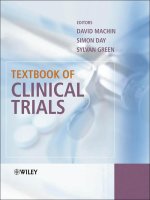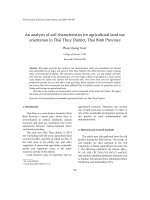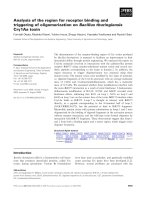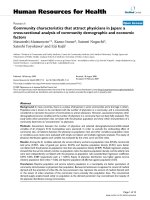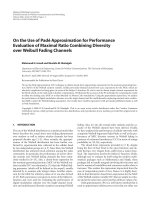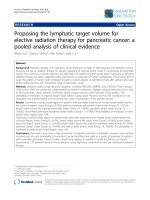Design analysis of clinical trials for economic evaluation reimbursement
Bạn đang xem bản rút gọn của tài liệu. Xem và tải ngay bản đầy đủ của tài liệu tại đây (8.31 MB, 332 trang )
Design & Analysis
of Clinical Trials for
Economic Evaluation
& Reimbursement
An Applied Approach
Using SAS & STATA
S
Iftekhar Khan
Design & Analysis
of Clinical Trials for
Economic Evaluation
& Reimbursement
An Applied Approach
Using SAS & STATA
Editor-in-Chief
Shein-Chung Chow, Ph.D., Professor, Department of Biostatistics and Bioinformatics,
Duke University School of Medicine, Durham, North Carolina
Series Editors
Byron Jones, Biometrical Fellow, Statistical Methodology, Integrated Information Sciences,
Novartis Pharma AG, Basel, Switzerland
Jen-pei Liu, Professor, Division of Biometry, Department of Agronomy,
National Taiwan University, Taipei, Taiwan
Karl E. Peace, Georgia Cancer Coalition, Distinguished Cancer Scholar, Senior Research Scientist
and Professor of Biostatistics, Jiann-Ping Hsu College of Public Health,
Georgia Southern University, Statesboro, Georgia
Bruce W. Turnbull, Professor, School of Operations Research and Industrial Engineering,
Cornell University, Ithaca, New York
Published Titles
Adaptive Design Methods in
Clinical Trials, Second Edition
Shein-Chung Chow and Mark Chang
Bayesian Analysis Made Simple:
An Excel GUI for WinBUGS
Phil Woodward
Adaptive Designs for Sequential
Treatment Allocation
Alessandro Baldi Antognini and
Alessandra Giovagnoli
Bayesian Methods for Measures of
Agreement
Lyle D. Broemeling
Adaptive Design Theory and
Implementation Using SAS and R,
Second Edition
Mark Chang
Advanced Bayesian Methods for
Medical Test Accuracy
Lyle D. Broemeling
Advances in Clinical Trial Biostatistics
Nancy L. Geller
Applied Meta-Analysis with R
Ding-Geng (Din) Chen and Karl E. Peace
Basic Statistics and Pharmaceutical
Statistical Applications,
Second Edition
James E. De Muth
Bayesian Adaptive Methods for
Clinical Trials
Scott M. Berry, Bradley P. Carlin,
J. Jack Lee, and Peter Muller
Bayesian Methods for Repeated Measures
Lyle D. Broemeling
Bayesian Methods in Epidemiology
Lyle D. Broemeling
Bayesian Methods in Health
Economics
Gianluca Baio
Bayesian Missing Data Problems:
EM, Data Augmentation and
Noniterative Computation
Ming T. Tan, Guo-Liang Tian,
and Kai Wang Ng
Bayesian Modeling in Bioinformatics
Dipak K. Dey, Samiran Ghosh,
and Bani K. Mallick
Benefit-Risk Assessment in
Pharmaceutical Research and
Development
Andreas Sashegyi, James Felli,
and Rebecca Noel
Published Titles
Biosimilars: Design and Analysis of
Follow-on Biologics
Shein-Chung Chow
Biostatistics: A Computing Approach
Stewart J. Anderson
Causal Analysis in Biomedicine and
Epidemiology: Based on Minimal
Sufficient Causation
Mikel Aickin
Clinical and Statistical
Considerations in Personalized
Medicine
Claudio Carini, Sandeep Menon,
and Mark Chang
Clinical Trial Data Analysis using R
Ding-Geng (Din) Chen and
Karl E. Peace
Clinical Trial Methodology
Karl E. Peace and
Ding-Geng (Din) Chen
Computational Methods in
Biomedical Research
Ravindra Khattree and
Dayanand N. Naik
Computational Pharmacokinetics
Anders Källén
Confidence Intervals for Proportions
and Related Measures of Effect Size
Robert G. Newcombe
Controversial Statistical Issues in
Clinical Trials
Shein-Chung Chow
Data Analysis with Competing Risks
and Intermediate States
Ronald B. Geskus
Data and Safety Monitoring
Committees in Clinical Trials
Jay Herson
Design and Analysis of Animal
Studies in Pharmaceutical
Development
Shein-Chung Chow and
Jen-pei Liu
Design and Analysis of Bioavailability
and Bioequivalence Studies,
Third Edition
Shein-Chung Chow and
Jen-pei Liu
Design and Analysis of Bridging
Studies
Jen-pei Liu, Shein-Chung Chow,
and Chin-Fu Hsiao
Design & Analysis of Clinical
Trials for Economic Evaluation
& Reimbursement : An Applied
Approach Using SAS & STATA
Iftekhar Khan
Design and Analysis of Clinical Trials
for Predictive Medicine
Shigeyuki Matsui, Marc Buyse,
and Richard Simon
Design and Analysis of Clinical Trials
with Time-to-Event Endpoints
Karl E. Peace
Design and Analysis of Non-Inferiority
Trials
Mark D. Rothmann, Brian L. Wiens,
and Ivan S. F. Chan
Difference Equations with Public
Health Applications
Lemuel A. Moyé and
Asha Seth Kapadia
DNA Methylation Microarrays:
Experimental Design and
Statistical Analysis
Sun-Chong Wang and
Arturas Petronis
Published Titles
DNA Microarrays and Related
Genomics Techniques: Design,
Analysis, and Interpretation of
Experiments
David B. Allison, Grier P. Page,
T. Mark Beasley, and Jode W. Edwards
Dose Finding by the Continual
Reassessment Method
Ying Kuen Cheung
Dynamical Biostatistical Models
Daniel Commenges and
Hélène Jacqmin-Gadda
Elementary Bayesian Biostatistics
Lemuel A. Moyé
Empirical Likelihood Method in
Survival Analysis
Mai Zhou
Interval-Censored Time-to-Event
Data: Methods and Applications
Ding-Geng (Din) Chen, Jianguo Sun,
and Karl E. Peace
Introductory Adaptive Trial Designs:
A Practical Guide with R
Mark Chang
Joint Models for Longitudinal
and Time-to-Event Data:
With Applications in R
Dimitris Rizopoulos
Measures of Interobserver
Agreement and Reliability,
Second Edition
Mohamed M. Shoukri
Medical Biostatistics, Third Edition
A. Indrayan
Exposure–Response Modeling:
Methods and Practical
Implementation
Jixian Wang
Meta-Analysis in Medicine and
Health Policy
Dalene Stangl and
Donald A. Berry
Frailty Models in Survival Analysis
Andreas Wienke
Mixed Effects Models for the
Population Approach: Models,
Tasks, Methods and Tools
Marc Lavielle
Fundamental Concepts for New
Clinical Trialists
Scott Evans and Naitee Ting
Generalized Linear Models:
A Bayesian Perspective
Dipak K. Dey, Sujit K. Ghosh,
and Bani K. Mallick
Handbook of Regression and
Modeling: Applications for the
Clinical and Pharmaceutical
Industries
Daryl S. Paulson
Inference Principles for
Biostatisticians
Ian C. Marschner
Modeling to Inform Infectious
Disease Control
Niels G. Becker
Modern Adaptive Randomized
Clinical Trials: Statistical and
Practical Aspects
Oleksandr Sverdlov
Monte Carlo Simulation for the
Pharmaceutical Industry: Concepts,
Algorithms, and Case Studies
Mark Chang
Multiple Testing Problems in
Pharmaceutical Statistics
Alex Dmitrienko, Ajit C. Tamhane,
and Frank Bretz
Published Titles
Noninferiority Testing in Clinical
Trials: Issues and Challenges
Tie-Hua Ng
Optimal Design for Nonlinear
Response Models
Valerii V. Fedorov and Sergei L. Leonov
Statistical Design and Analysis
of Clinical Trials: Principles and
Methods
Weichung Joe Shih and Joseph Aisner
Statistical Design and Analysis of
Stability Studies
Shein-Chung Chow
Patient-Reported Outcomes:
Measurement, Implementation and
Interpretation
Joseph C. Cappelleri, Kelly H. Zou,
Andrew G. Bushmakin, Jose Ma. J. Alvir,
Demissie Alemayehu, and
Tara Symonds
Statistical Evaluation of Diagnostic
Performance: Topics in ROC Analysis
Kelly H. Zou, Aiyi Liu, Andriy Bandos,
Lucila Ohno-Machado, and
Howard Rockette
Quantitative Evaluation of Safety in
Drug Development: Design, Analysis
and Reporting
Qi Jiang and H. Amy Xia
Statistical Methods for Drug Safety
Robert D. Gibbons and Anup K. Amatya
Statistical Methods for Clinical Trials
Mark X. Norleans
Quantitative Methods for Traditional
Chinese Medicine Development
Shein-Chung Chow
Statistical Methods for
Immunogenicity Assessment
Harry Yang, Jianchun Zhang,
Binbing Yu, and Wei Zhao
Randomized Clinical Trials of
Nonpharmacological Treatments
Isabelle Boutron, Philippe Ravaud,
and David Moher
Statistical Methods in Drug
Combination Studies
Wei Zhao and Harry Yang
Randomized Phase II Cancer
Clinical Trials
Sin-Ho Jung
Sample Size Calculations for
Clustered and Longitudinal
Outcomes in Clinical Research
Chul Ahn, Moonseong Heo,
and Song Zhang
Sample Size Calculations in Clinical
Research, Second Edition
Shein-Chung Chow, Jun Shao,
and Hansheng Wang
Statistical Analysis of Human
Growth and Development
Yin Bun Cheung
Statistics in Drug Research:
Methodologies and Recent
Developments
Shein-Chung Chow and Jun Shao
Statistics in the Pharmaceutical
Industry, Third Edition
Ralph Buncher and Jia-Yeong Tsay
Survival Analysis in Medicine
and Genetics
Jialiang Li and Shuangge Ma
Theory of Drug Development
Eric B. Holmgren
Translational Medicine: Strategies
and Statistical Methods
Dennis Cosmatos and
Shein-Chung Chow
Design & Analysis
of Clinical Trials for
Economic Evaluation
& Reimbursement
An Applied Approach
Using SAS & STATA
Iftekhar Khan
University College London, UK
CRC Press
Taylor & Francis Group
6000 Broken Sound Parkway NW, Suite 300
Boca Raton, FL 33487-2742
© 2016 by Taylor & Francis Group, LLC
CRC Press is an imprint of Taylor & Francis Group, an Informa business
No claim to original U.S. Government works
Version Date: 20150722
International Standard Book Number-13: 978-1-4665-0548-3 (eBook - PDF)
This book contains information obtained from authentic and highly regarded sources. Reasonable efforts
have been made to publish reliable data and information, but the author and publisher cannot assume
responsibility for the validity of all materials or the consequences of their use. The authors and publishers
have attempted to trace the copyright holders of all material reproduced in this publication and apologize to
copyright holders if permission to publish in this form has not been obtained. If any copyright material has
not been acknowledged please write and let us know so we may rectify in any future reprint.
Except as permitted under U.S. Copyright Law, no part of this book may be reprinted, reproduced, transmitted, or utilized in any form by any electronic, mechanical, or other means, now known or hereafter invented,
including photocopying, microfilming, and recording, or in any information storage or retrieval system,
without written permission from the publishers.
For permission to photocopy or use material electronically from this work, please access www.copyright.
com ( or contact the Copyright Clearance Center, Inc. (CCC), 222 Rosewood
Drive, Danvers, MA 01923, 978-750-8400. CCC is a not-for-profit organization that provides licenses and
registration for a variety of users. For organizations that have been granted a photocopy license by the CCC,
a separate system of payment has been arranged.
Trademark Notice: Product or corporate names may be trademarks or registered trademarks, and are used
only for identification and explanation without intent to infringe.
Visit the Taylor & Francis Web site at
and the CRC Press Web site at
These are our works, these works our souls display;
Behold our works when we have passed away.
First and foremost, I give thanks to God Almighty for giving me the health
and energy to complete this project. I dedicate this book to those who I
remember in my dreams and made this possible: my wife Suhailah, my children Yohanis and Hanzalah, my late father Ayub Khan and Asghari Khan,
who was always kind to me and provided much encouragement. I also thank
all those who supported me while I was completing this project, family and
friends, past and present.
Contents
Preface.................................................................................................................... xix
Author.................................................................................................................. xxiii
Acronyms............................................................................................................. xxv
1. Introduction to Economic Evaluation.......................................................... 1
1.1 Health Economics, Pharmacoeconomics and Economic
Evaluation................................................................................................ 1
1.2 Important Concepts in Economic Evaluation.................................... 4
1.2.1Value........................................................................................... 5
1.2.2 Allocative Efficiency................................................................. 6
1.2.3 Technical Efficiency.................................................................. 7
1.2.4Reimbursement.........................................................................7
1.2.5 Opportunity Cost.....................................................................8
1.2.6Discounting............................................................................... 8
1.3 Health Economic Evaluation and Drug Development................... 11
1.4 Efficacy, Effectiveness and Efficiency................................................ 14
1.5 When Is a Pharmacoeconomic Hypothesis Possible?..................... 18
1.5.1Hypotheses.............................................................................. 18
1.5.1.1Superiority................................................................ 18
1.5.1.2 Non-Inferior Equivalence....................................... 19
1.5.1.3 Non-Inferior Equivalence Where ΔA−S < 0
(Case II)..................................................................... 20
Exercises for Chapter 1...................................................................................22
2. Health Economic Evaluation Concepts..................................................... 25
2.1 Incremental Cost-Effectiveness Ratio (ICER)................................... 25
2.2 Incremental INMB............................................................................... 28
2.3 The Concept of Dominance................................................................ 38
2.4 Types of Economic Evaluation........................................................... 39
2.4.1CUA........................................................................................... 40
2.4.2CEA........................................................................................... 41
2.4.3 Cost–Benefit Analysis (CBA).................................................42
2.4.4 Cost-Minimisation Analysis.................................................42
2.5 Statistical versus Health Economic Models.....................................43
2.5.1 Deterministic Model.............................................................. 45
2.5.2 Statistical Model...................................................................... 46
Exercises for Chapter 2................................................................................... 48
Appendix 2A: SAS/STATA Code................................................................. 48
xi
xii
Contents
3. Designing Cost-Effectiveness into a Clinical Trial................................ 53
3.1 Reasons for Collecting Economic Data in a Clinical Trial............. 53
3.2 Planning a Health Economic Evaluation in a Clinical Trial.......... 56
3.2.1 Costs/Resource Use and Effects Collected
Prospectively......................................................................... 56
3.2.2 Clinical Effects Are Collected Prospectively but
Some Health Resource and Quality-of-Life Data Are
Collected Retrospectively...................................................... 57
3.2.3 Clinical Effects and Outcomes Are Collected
Retrospectively........................................................................ 58
3.3 Clinical Trial Design Issues in an Economic Evaluation................ 60
3.4 Integrating Economic Evaluation in a Clinical Trial:
Considerations...................................................................................... 61
3.4.1 End Points and Outcomes..................................................... 61
3.4.2 Timing of Measurements.......................................................64
3.4.3 Trial Design.............................................................................65
3.4.4 CRF Design.............................................................................. 66
3.4.5 Sample Size and Power.......................................................... 66
3.4.6 Treatment Pathway................................................................. 66
3.4.7 Date of Generic Entry............................................................. 67
3.4.8 Treatment Compliance........................................................... 67
3.4.9 Identify Subgroups/Heterogeneity...................................... 68
3.4.10 Early ICER/INMB................................................................... 69
3.4.11 Multicentre Trials.................................................................... 69
3.5 CRF Design and Data Management Issues...................................... 76
3.6 Case Study of a Lung Cancer Trial with an Economic
Evaluation..............................................................................................77
3.6.1 Trial Design.............................................................................77
3.6.2 Treatment Pathway.................................................................77
3.6.3 Choice of Comparator............................................................ 78
3.6.4 End Points and Outcomes..................................................... 79
3.6.5 Power and Sample Size.......................................................... 79
3.6.6 Date of Generic Entry............................................................. 79
3.6.7 Follow-Up Time (Time Horizon).......................................... 79
3.6.8Compliance..............................................................................80
3.6.9 Timing of Measurements.......................................................80
3.6.10 CRF Design..............................................................................80
3.6.11 Identify and Understand Treatment Pathway.................... 82
3.6.12 Early ICER/INMB................................................................... 82
3.6.13 Define Subgroups................................................................... 82
3.6.14 Multinational and Multicentre Trials..................................83
Exercises for Chapter 3...................................................................................83
Appendix 3A: SAS/STATA Code.................................................................83
Contents
xiii
4. Analysing Cost Data Collected in a Clinical Trial................................. 85
4.1 Collecting and Measuring Costs for the Case Report Form.......... 85
4.1.1 Costs versus Resource Use.................................................... 85
4.2 Types of Costs....................................................................................... 88
4.3 Other Concepts in Costs: Time Horizon and Discounting............ 89
4.3.1 Time Horizon..........................................................................90
4.3.2Discounting............................................................................. 91
4.4 CRFs for Collecting Resource Use Data in Clinical Trials............. 92
4.5 Statistical Modelling of Cost Data..................................................... 92
4.5.1 Distribution of Costs.............................................................. 94
4.5.2 Analysing Costs Assuming the Data Are Normally
Distributed............................................................................... 94
4.5.3 Transforming Cost Data....................................................... 100
4.6 Using Generalised Linear Models to Analyse Cost Data............ 101
4.7 Models for Skewed Distributions Outside the GLM Family
of Distributions.................................................................................. 104
4.8 Summary of Modelling Approaches............................................... 105
4.9 Handling Censored and Missing Costs......................................... 106
4.10 Strategies for Avoiding Missing Resource Data............................ 107
4.11 Strategies for Analysing Cost Data When Data Are Missing
or Censored......................................................................................... 108
4.12 Imputation Methods.......................................................................... 109
4.13 Censored Cost Data........................................................................... 109
4.14 Method of Lin..................................................................................... 110
4.15 Summary and Conclusion................................................................ 112
Exercises for Chapter 4................................................................................. 112
Appendix 4A: SAS/STATA Code............................................................... 113
5. Quality of Life in Economic Evaluation................................................. 117
5.1 Quality of Life in Clinical Trials versus Quality of Life for
Economic Evaluation......................................................................... 117
5.2 Disease-Specific and Generic Measures of HRQoL...................... 118
5.3 HRQoL Instruments Used for the Purposes of Economic
Evaluation............................................................................................ 120
5.3.1 EQ-5D: Generating Health States and Applying
Preference Weights............................................................... 120
5.4 When HRQoL Data Have Not Been Collected in a Clinical
Trial...................................................................................................... 122
5.4.1 Mapping Functions.............................................................. 122
5.5 HRQoL Metrics for Use in Economic Evaluations........................ 127
5.5.1QALY....................................................................................... 127
5.5.1.1 QALY Calculation Using the AUC with
Patient-Level Data................................................. 128
xiv
Contents
5.5.1.2 Calculation of the QALY Using
Summarised EQ-5D Data When the
Primary End Point Is Survival (Censored
Data)........................................................................ 129
5.5.1.3 Adjusting for Pre-Progression and PostProgression HRQoL.............................................. 133
5.5.1.4 Calculation of the QALY Using
Summarised EQ-5D Data When the
Primary End Point Is Not a Survival/
Time-to-Event End Point (Short-Term
Health Gains).....................................................135
5.5.2Q-TWiST................................................................................. 139
5.5.2.1 The TWiST Component........................................ 139
5.5.2.2 Adding HRQoL with the TWiST Component....140
5.5.3 Disability-Adjusted Life Year (DALY)................................ 141
5.5.4 Statistical Issues with HRQoL Data................................... 142
5.5.4.1 Missing QoL Data................................................. 142
5.5.4.2 Effect Sizes.............................................................. 143
5.5.4.3 Methods of Analysis............................................. 143
5.6 Are Utility Measures Sensitive Enough for Detecting
Treatment Differences?...................................................................... 144
Exercises for Chapter 5................................................................................. 144
Appendix 5A: SAS/STATA Code............................................................... 145
Technical Appendix 5B: Beta Binomial Technical Details....................... 146
Technical Appendix 5C: Technical Summary of the GLM...................... 148
6. Modelling in Economic Evaluation......................................................... 149
6.1 Introduction to Modelling: Statistical versus Economic
Modelling............................................................................................ 149
6.2 Decision Tree Models........................................................................ 150
6.3 Markov Modelling/Cohort Simulation.......................................... 153
6.3.1 Understanding the Transition Matrix................................ 153
6.3.2 Duration of Time................................................................... 156
6.3.3 Checking the Model............................................................. 160
6.4 Analysis of Patient-Level Data......................................................... 160
6.4.1 Patient-Level Costs................................................................ 161
6.4.2 Patient-Level Effects (Utilities and Efficacy)..................... 161
6.4.2.1Treatments.............................................................. 162
6.4.2.2Costs/Resources.................................................... 162
6.4.2.3 Drug Costs.............................................................. 163
6.4.2.4 Supportive Care..................................................... 163
6.4.2.5 Clinic Visits/Admissions...................................... 163
6.4.2.6AEs.......................................................................... 163
6.4.2.7Utilities.................................................................... 164
Contents
xv
6.4.2.8 Statistical and Cost-Effectiveness Analysis....... 164
6.4.3Results.................................................................................... 165
6.4.3.1Costs/Resources.................................................... 166
6.4.3.2Efficacy.................................................................... 166
6.4.3.3 Utilities and QALYs............................................... 166
6.5 Patient-Level Simulation................................................................... 168
6.6 Other Issues in Modelling................................................................ 170
Exercises for Chapter 6................................................................................. 171
Appendix 6A: SAS/STATA Code............................................................... 172
7. Sensitivity Analyses................................................................................... 175
7.1 Introduction to Sensitivity Analysis............................................... 175
7.2 One-Way Sensitivity Analysis.......................................................... 176
7.3 Two-Way Sensitivity Analysis.......................................................... 177
7.4PSA....................................................................................................... 178
7.5 Bayesian Sensitivity Analyses.......................................................... 182
7.6 Issues in Interpreting and Reporting Results from
Sensitivity Analysis........................................................................... 187
7.6.1 Interpreting the CEAC and Cost-Effectiveness Plane..... 187
Exercises for Chapter 7................................................................................. 190
Appendix 7A: SAS/STATA Code............................................................... 190
8. Sample Size and Value of Information for Cost-Effectiveness
Trials............................................................................................................... 201
8.1Introduction........................................................................................ 201
8.2 Sample Sizes for Cost-Effectiveness................................................ 201
8.3 Sample Size Methods for Efficacy................................................... 202
8.4 Sample Size Formulae for Cost-Effectiveness: Examples............. 203
8.5 Factors Affecting Sample Sizes........................................................ 208
8.5.1 Effects of Variation in Correlation (between Cost
and Efficacy Measures) on Sample Sizes........................... 208
8.5.2 The Effect of the Cost-Effectiveness Threshold (λ)
on the Sample Size Depends on the Correlation
Coefficient.............................................................................. 209
8.6 The Minimum Sample Size to Establish Cost-Effectiveness....... 210
8.7 Bayesian Sample Size Approach...................................................... 212
8.7.1 The Effect of the Correlation and λ on the Bayesian
Sample Size............................................................................ 213
8.8 The Normality Assumption............................................................. 218
8.9 Obtaining the Necessary Data and Tools for Calculating
Sample Size......................................................................................... 219
8.10 Value of Information.......................................................................... 220
Exercises for Chapter 8................................................................................. 226
Appendix 8A: SAS/STATA Code............................................................... 227
Technical Appendix 8B: Derivation of Sample Size Formula................. 227
xvi
Contents
Technical Appendix 8C: Comparison with Briggs and Tambour’s
(2001) Approach................................................................................. 230
9. Mixed Treatment Comparisons, Evidence Synthesis........................... 233
9.1Introduction........................................................................................ 233
9.2MTCs.................................................................................................... 233
9.2.1 Direct Comparison...............................................................234
9.2.2 Indirect Treatment Comparison (ITC)...............................234
9.2.3Meta-Analysis........................................................................234
9.2.4 Network of Evidence............................................................234
9.2.5 Assumptions for Carrying Out MTCs............................... 235
9.3Meta-Analysis..................................................................................... 237
9.3.1 Prior Distribution.................................................................. 238
9.3.2 Results (Partial Extract)........................................................ 242
Exercises for Chapter 9................................................................................. 243
Appendix 9A: SAS/STATA Code............................................................... 243
10. Cost-Effectiveness Analyses of Cancer Trials....................................... 245
10.1Introduction........................................................................................ 245
10.1.1 Costs of Cancer Care............................................................ 245
10.2 Modelling Patient-Level Data from Cancer Trials for CostEffectiveness....................................................................................... 248
10.2.1 Kaplan–Meier Methods....................................................... 249
10.2.2 Semi-Parametric Methods................................................... 249
10.2.3 Parametric Methods............................................................. 250
10.2.3.1 Weibull Model....................................................... 251
10.3 Flexible Parametric Survival Models.............................................. 253
10.3.1 Applications in Cancer Surveillance..................................254
10.4 Modelling Survival Data Using a Flexible Parametric Model.....254
10.4.1Background............................................................................254
10.4.2 SAS Macro Call...................................................................... 255
10.4.3Results.................................................................................... 255
10.5 Cost-Effectiveness of Lenalidomide................................................ 256
10.5.1Background............................................................................ 256
10.5.2 Design, Patients and Treatment Schedule......................... 256
10.5.3Costs........................................................................................ 257
10.5.4 Cost-Effectiveness Modelling.............................................. 259
10.6 Transition Probabilities and Survival Rates................................... 263
10.7 Handling Crossover (Treatment Switching) in Cancer Trials..... 265
10.7.1ITT........................................................................................... 266
10.7.2 Per Protocol (PP) Analysis................................................... 267
10.7.3IPCW....................................................................................... 267
10.7.4RPFSTM.................................................................................. 268
Contents
xvii
10.8 Landmark Analysis and Presenting Survival Data by
Tumour Response.............................................................................. 269
Exercises for Chapter 10............................................................................... 271
Appendix 10A: SAS/STATA Code............................................................. 271
11. The Reimbursement Environment.......................................................... 275
11.1 Regulatory Requirements for Clinical Efficacy versus Payer
Requirements for Value..................................................................... 275
11.2 Reimbursement and Payer Evidence Requirements across
Different Countries............................................................................ 277
11.3 Market Access and Strategy............................................................. 278
11.4 Value-Based Pricing........................................................................... 278
11.5 Submissions for Payer Evidence...................................................... 281
11.6 Further Areas for Research.............................................................. 283
Exercises for Chapter 11............................................................................... 285
References............................................................................................................ 287
Bibliography......................................................................................................... 297
Preface
Economic evaluation is a firmly established discipline in the field of health
research and policymaking. It has also become an increasingly essential
component of clinical trial design to show that new treatments (healthcare
technologies) offer value to the payers in various healthcare systems.
Several books already exist which address theoretical or practical aspects
of cost-effectiveness analysis. What makes this book different from others
is its insight into how health economic evaluation is applied in a clinical
trial context in both academic and pharmaceutical/commercial settings.
This book is not just about performing cost-effectiveness analyses, but it also
emphasises the strategic importance of economic evaluation and offers guidance and advice on the complex factors at play before, during and after an
economic evaluation has been performed. In addition, this book bridges the
gap between applications of economic evaluation in industry (mainly pharmaceutical) and what students may learn in university courses.
An additional feature of this work is the availability of software, such as
SAS and STATA code, for performing, in some cases, daunting computations.
In addition, Windows-based software (SCET-VA® version 1.0) for sample size
and value of information analysis, which is a menu-driven package avoiding
the need for complex programming, is available free of charge. Therefore,
this book will be a valuable source of knowledge for students who might
pursue a career in this field or simply wish to know more about applying
economic evaluation techniques.
Design & Analysis of Clinical Trials for Economic Evaluation & Reimbursement:
An Applied Approach Using SAS & STATA is structured to cover many of the
topics in economic evaluation that students, clinicians, health economists,
epidemiologists, statisticians and other healthcare researchers will come
across when designing a clinical trial for cost-effectiveness. No knowledge of
economic evaluation, statistics or SAS is required to understand the key concepts in each chapter of the book, and the reader may ignore the SAS/STATA
code and read interpretations of the output (the interpretations would be the
same with any software).
This book can be used as either a self-study book, a textbook or a reference
book. The format of the book is as follows.
Chapter 1 offers the reader who is unfamiliar with economic evaluation the economic background and context. Important economic concepts
such as opportunity costs, discounting and the marketing authorisation
landscape are reviewed. The clinical hypotheses are discussed in the context of economic hypotheses. The chapter discusses practical examples of
strategic thinking necessary when developing a new treatment for market
authorisation.
xix
xx
Preface
Chapter 2 introduces the incremental cost-effectiveness ratio, the costeffectiveness plane and the different types of economic evaluation undertaken using the incremental net monetary benefit approach, and distinguishes
between statistical and economic models. Chapter 3 elaborates on the detailed
aspects of clinical trial design for cost-effectiveness, covering issues such as
choice of comparator, timing of assessments, clinical report form design,
treatment pathways and heterogeneity. The chapter contains a case study
from a lung cancer trial.
Chapters 4 and 5 contain material on the analysis of resource use (costs)
and quality of life, respectively. Chapter 4 discusses some of the more recent
statistical issues and approaches to modelling cost data, distinguishing
carefully between modelling health resource data and costs data. Chapter 5
covers the different measures of quality of life used in economic evaluations,
such as EQ-5D, quality-adjusted life years, disability-adjusted life years and
quality of time spent without symptoms of disease and toxicity. A section
also includes more recent research into evaluating the sensitivity of generic
measures to detect treatment effects. Mapping functions are also covered:
methods applied in practice to estimate health utilities but not often covered
in standard texts.
Chapters 6 and 7 detail the approaches to economic modelling and sensitivity analysis. Chapter 6 elaborates on decision trees and Markov and
patient-level simulation approaches as well as discussing strategies for
checking the Markov model – an area rarely discussed in standard texts but
almost always required in industry applications. Chapter 7 provides details
on approaches to simulating univariate and multivariate data for probabilistic sensitivity analysis. The complexities of multivariate simulation for
probabilistic sensitivity analysis are, again, rarely discussed in most books
on health economic evaluation.
Chapter 8 provides extensive details on sample size and power in a
Bayesian and frequentist context. A demonstration of the freely available
software for sample sizes and value of information methods using SCET-VA
v1.0® discusses how to enter inputs to obtain the sample size required for a
given probability of cost-effectiveness.
Chapter 9, although seemingly the odd one out, is still nevertheless relevant, since in most industry applications of cost-effectiveness and economic
evaluation, evidence synthesis is often required. Indirect comparisons are
sometimes needed to compare treatments that were not compared in the
same trial, and some reimbursement agencies do request these. For this reason, this chapter was included, as it complements the methods applied in
economic evaluation, particularly for market authorisation.
Chapter 10 is dedicated to examples of economic evaluation specific to cancer trials. Key design aspects of Phase III cancer trials, issues such as extrapolation of survival times after a study follow-up has been completed, treatment
switching after disease progression and the relationship between transition
probabilities and hazard ratios, as well as other practical considerations
Preface
xxi
when designing and analysing cancer trials for economic evaluation, are discussed. Again, this is an area which is needed, but many standard texts do
not distinguish between the peculiarities of economic evaluation in cancer
trials and other therapeutic areas. Chapter 11 finally summarises the details
and challenges of the reimbursement market in practice and further areas of
research in the area.
I candidly admit that my objectives have been set high when structuring
this book. Economic evaluation covers several disciplines, and addressing
all of these has been challenging. I hope that the material in this book is
suitable for a range of researchers of varying abilities, so that some will find
the entire book useful, whereas for others some chapters will be useful. As
a student textbook, it can be complemented by additional reading materials
suggested in the bibliography to provide a book whereby students can be
more prepared for the world of industry.
I acknowledge the anonymous reviewers of this book and the early discussions with various researchers at University College London, which have
helped to improve the text. I am also grateful to the Cancer Research UK
(CRUK) and Cancer Trials Centre, who respected my desire to see this project to completion while running multiple clinical trials. Finally, I thank Drs
Suhailah Khan, Yohanis and Hanzalah for putting up with my countless
hours on this book.
Iftekhar Khan
University College London
/>
Author
Iftekhar Khan is a statistician, health economics researcher and academic at
University College London (University of London). He has been an applied
statistician for over 15 years in clinical trials, having worked in pharmaceutical companies and academic clinical trials units. Dr. Khan has earned
degrees in statistics and mathematics from King’s College London, the
University of Kent and the University of Cambridge, including a master’s
in health economics and a PhD in health economic modelling (University
College London).
xxiii

